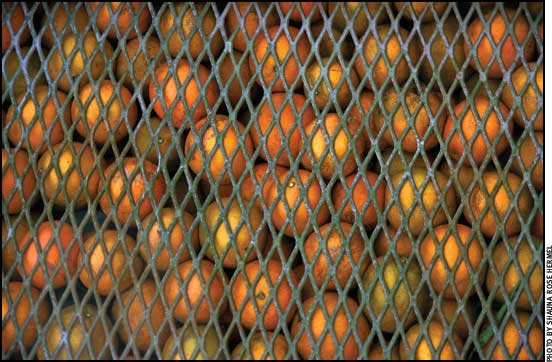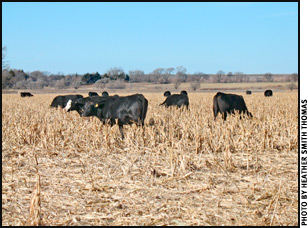HEALTH & NUTRITION...

Cleansing From the Inside Out
Essential oils in citrus products provide a natural antibiotic effect.
USDA scientists and their collaborators have conducted a series of studies that explore nonantibiotic methods to reduce foodborne pathogens that are found in the gut of food animals. Early studies showed that citrus products provide cows with good roughage and vitamins, and the essential oils in such products provide a natural antibiotic effect. Recent studies have investigated the use of processed orange peel pellets. Read more.
Lower Your Feed Cost
Tips to design a winter cattle-feeding strategy that doesn't break the bank.
Feeding cattle in the winter can be the single, largest expense for producers. University of Kentucky (UK) College of Agriculture beef specialist Roy Burris said this year will not be an exception.
"Due to high input costs, mainly grain and concentrates, this year will present a challenge to producers," said Burris, stationed at UK's Research and Education Center in Princeton. "There are several management practices that producers can use to lower feed costs and make their herds more profitable." Read more.
 Alternative Feeds
Alternative Feeds
Producers have several options when looking for protein to supplement poor-quality forage.
On dry years, or whenever hay is expensive, alternative feeds can help stretch or replace traditional forages. Feasibility of alternatives will depend on your location and how much freight is involved.
Poor-quality forages can be supplemented with many protein sources, says Craig Iwanski, veterinarian and owner of Central Veterinary Services, Stockton, Kan.
"In our part of the country some producers use wet distillers' grain, which can be fed at 10 pounds (lb.) a day to get the necessary pound of protein," he says. "It's also a good energy source. Producers just need to be careful how much they feed. If it's more than 40% of the total dry matter in the ration, you have to watch sulfur content." Read more.

Rick Rasby
Ridin’ Herd
Don't overlook condition scoring.
It has been a while since we have covered condition-scoring cows in this column. Body condition of spring-calving cows at the time of calving has an effect on your herd. For spring-calving cows, body condition score (BCS) at calving affects the calf at calving time and cow performance during the breeding season. Overconditioning cows, especially if the extra condition was "fed on," is wasting money. Underconditioned cows are risky because their performance can be inconsistent. A properly conditioned cow herd at the right time during the production cycle is the goal. The importance of this management practice cannot be overlooked this year as input costs, especially feed costs, continue to increase. Read more.
Antibiotic Use Discussion
Symposium establishes new benchmark for information, science.
Researchers and experts in animal health and human health shared scientific and thought-provoking information that elicited numerous "a-ha's" from participants of the "Antibiotic Use in Food Animals: A Dialogue for a Common Purpose" symposium, Oct. 26-27, in Chicago. Sponsored by the National Institute for Animal Agriculture (NIAA), the symposium provided a two-way dialogue, with attendees asking pointed questions and adding to the discussions.
"The symposium established a new benchmark of valuable information and science that can be used to further communicate valid and essential facts to animal agriculture producers, as well as consumers, regarding the use of antibiotics in food animal production," states Leonard Bull, who served as planning committee chairman for the symposium. "Divergent opinions were openly expressed, and areas of consensus were developed." Read more.
The Challenge of L. hardjo-bovis
USDA approves two vaccines already available for preventing the disease.
Leptospirosis has long been a health challenge in cattle. Leptospira, which often infect calves at a young age and easily spread within herds, ultimately can cause reproductive failure and significant economic loss. Extensive research to better understand this costly disease has identified that Leptospira borgpetersenii hardjo-bovis is the only species of L. hardjo found in the United States.
Once cattle have L. hardjo, which colonizes in the kidneys and reproductive tract, they can shed the organism in urine, placental fluids, milk and other infected fluids for weeks to months after infection. As herdmates come in contact with these fluids — or even contaminated water or small cuts in the skin of infected animals — infections can spread quickly. Read more.
New Edition of Veterinarian Johne's Disease Handbooks Available
Beef producers and their veterinarians who want to help prevent or control Johne's disease in their herds often ask where they should start with the process. The answer: Begin by conducting an on-farm risk assessment, then develop and follow a management plan specific to a farm or ranch.
Two recently updated handbooks — Handbook for Veterinarians and Beef Producers and How to do Risk Assessments and Develop Management Plans for Johne's Disease — are available for beef producers and their veterinarians who are serious about addressing Johne's disease and stopping the financial drain of this devastating disease. The handbooks, now in their fourth editions, reflect the USDA's updated Program Standards for the Voluntary Bovine Johne's Disease Control Program and are significantly more user-friendly. Read more.
Cattle Diseases: Common Conditions/Terms
Click here for a list of common conditions and terms related to beef cattle diseases, such as anaplasmosis, brucellosis, BVD, E. coli, IBR and others.
[Click here to go to the top of the page.]













